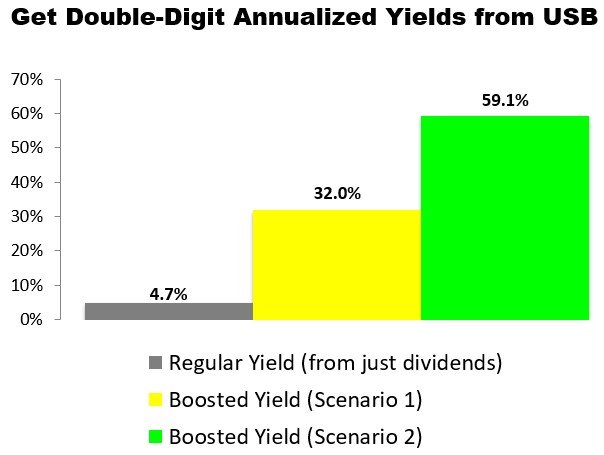Today we’ll show you how to make outsized income from American bank holding company U.S. Bancorp (USB). Banks have arguably never been stronger or more durable than they are today, and by every single basic valuation metric USB is well off of its own respective recent historical average.
In fact, Jason Fieber just identified USB and one of his top five stocks to buy for October 2022.
Shares of USB yield a juicy 4.7% right now, but by selling a covered call option we can create even higher income instantly — generating an annualized yield of 32% to 59% in the process.
Here’s how…
As we go to press, USB is selling for $40.73 per share and the November 11 $42 calls are going for about $1.50 per share.
Our income trade would involve buying 100 shares of USB and simultaneously selling one of those calls.
By selling a call option, we would be giving the buyer of the option the right, but not the obligation, to purchase our 100 shares at $42 per share (the “strike” price) anytime before November 11 (the contract “expiration” date).
In exchange for that opportunity, the buyer of the option would be paying us $1.50 per share (the “premium”).
There are two likely ways this trade would work out, and they both offer significantly higher income than what we’d collect if we relied on the stock’s dividends alone.

To be conservative, we don’t include any dividends in our calculations for either of the following scenarios. The annualized yields are generated from options premium and applicable capital gains alone. So any dividends collected are just “bonus” that will boost our overall annualized yields even further.
Let’s take a closer look at each scenario…
Scenario #1: USB stays under $42 by November 11
If USB stays under $42 by November 11, our option contract would expire and we’d get to keep our 100 shares.
In the process, we’d receive $150 in premium ($1.50 x 100 shares).
That income would be collected instantly, when the trade opens.
Excluding any commissions, if “Scenario 1” plays out, we’d receive a 3.7% return in the form of income for selling the covered call ($1.50 / $40.73). Since we’d be in the trade for 42 days, this scenario would work out to a 32% annualized yield.
Scenario #2: USB climbs over $42 by November 11
If USB climbs over $42 by November 11, our 100 shares would get sold (“called away”) at $42 per share.
In “Scenario 2” — like “Scenario 1” — we’d collect an instant $150 in premium ($1.50 x 100 shares) when the trade opens. We’d also generate $127 in capital gains when the trade closes because we’d be buying 100 shares at $40.73 and selling them at $42.00.
In this scenario, excluding any commissions, we’d be looking at a $277 profit.
From a percentage standpoint, this scenario would deliver an instant 3.7% in income for selling the covered call ($1.50 / $40.73) and a 3.1% return from capital gains ($1.27 / $40.73).
At the end of the day, we’d be looking at a 59.1% annualized yield from USB.
Here’s how we’d make the trade…
We’d place a “Buy-Write” options order with a Net Debit price of as close to $39.23 ($40.73 – $1.50) as we can get — the lower the better. Options contracts work in 100-share blocks, so we’d have to buy at least 100 shares of U.S. Bancorp (USB) for this trade. For every 100 shares we’d buy, we’d “Sell to Open” one options contract using a limit order. Accounting for the $150 in premium we’d collect, that would require a minimum investment of $3,923.
Hope this helps!
Phil Lamanna and Greg Patrick
When Tim Cook stood in the Oval Office last week, all eyes were on the "unique 24K gold gift" he presented to President Trump. But many viewers missed an even more important moment in that 30-second clip. One that unmistakably singled out what Futurist Eric Fry calls "possibly the best AI investment anyone could make right now." Eric believes this little-known partner to Apple could go crazy over the next 12-24 months, potentially leaving well-known AI stocks like Nvidia, Microsoft and Google in the dust. Click to get full details on the company.
P.S.. We’d only make this trade if: 1) we wanted to own the underlying stock anyways 2) we believed it was trading at a reasonable price 3) we were comfortable owning it for the long-haul in case the price drops significantly below our cost basis by expiration and 4) we were comfortable letting it go if shares get called away. To be mindful of position sizing, except in rare cases, the value of this trade wouldn’t exceed 5% of our total portfolio value. In addition, to minimize taxes and tax paperwork, we would most likely make this trade in a retirement account, such as an IRA or 401(k).
Please note: We’re not registered financial advisors and these aren’t specific recommendations for you as an individual. Each of our readers have different financial situations, risk tolerance, goals, time frames, etc. You should also be aware that some of the trade details (specifically stock prices and options premiums) are certain to change from the time we do our research, to the time we publish our article, to the time you’re alerted about it. So please don’t attempt to make this trade yourself without first doing your own due diligence and research.
Source: Trades of the Day

